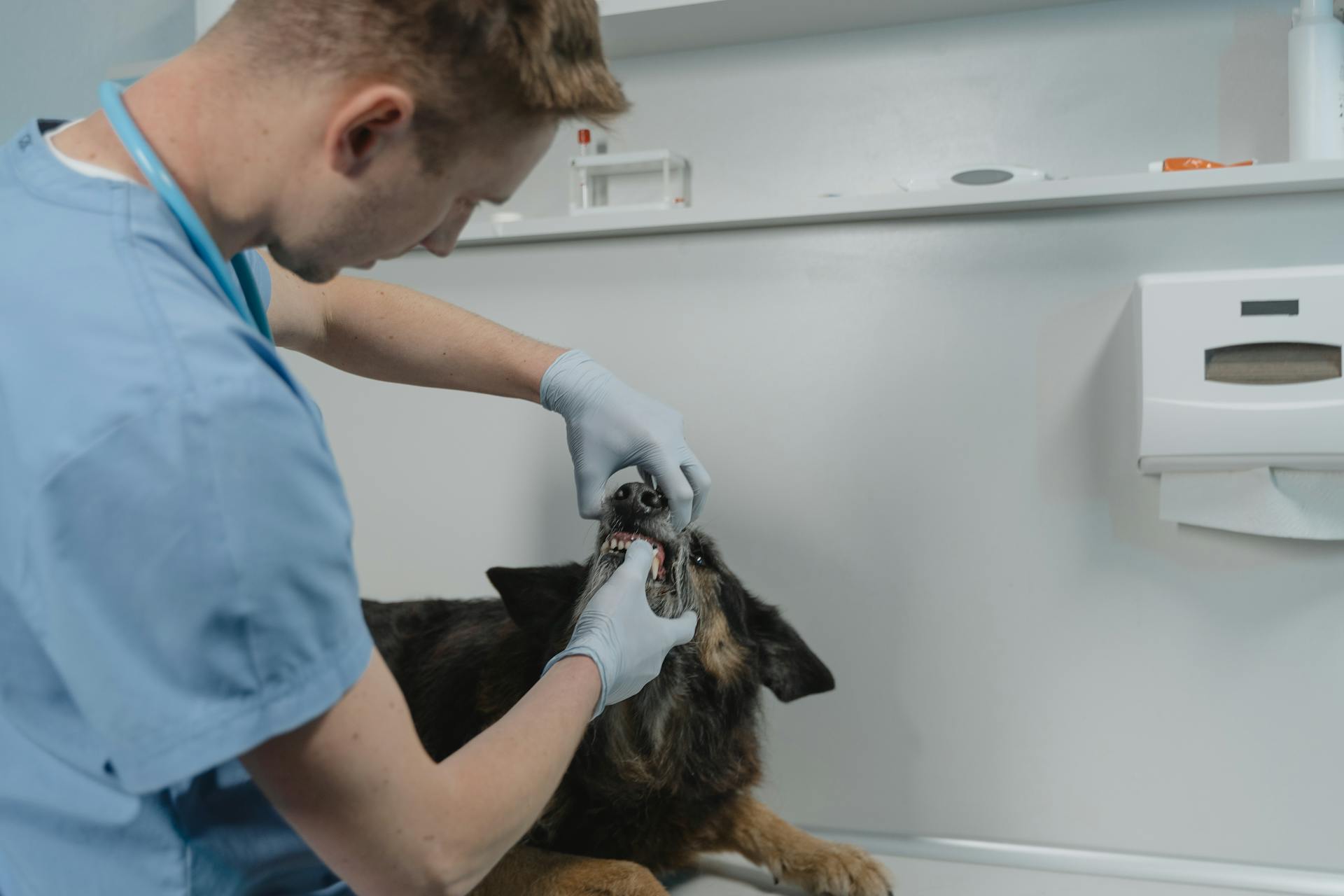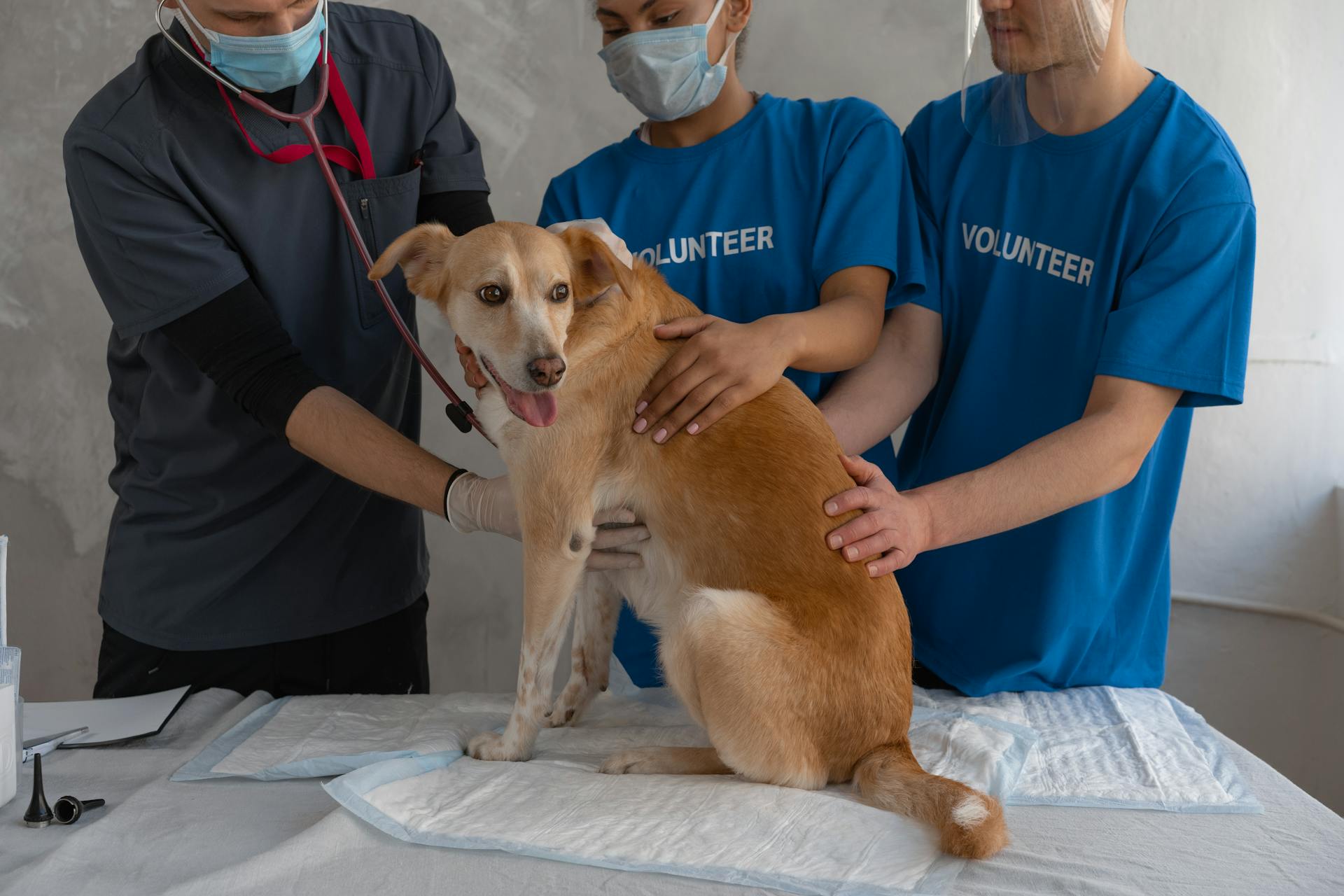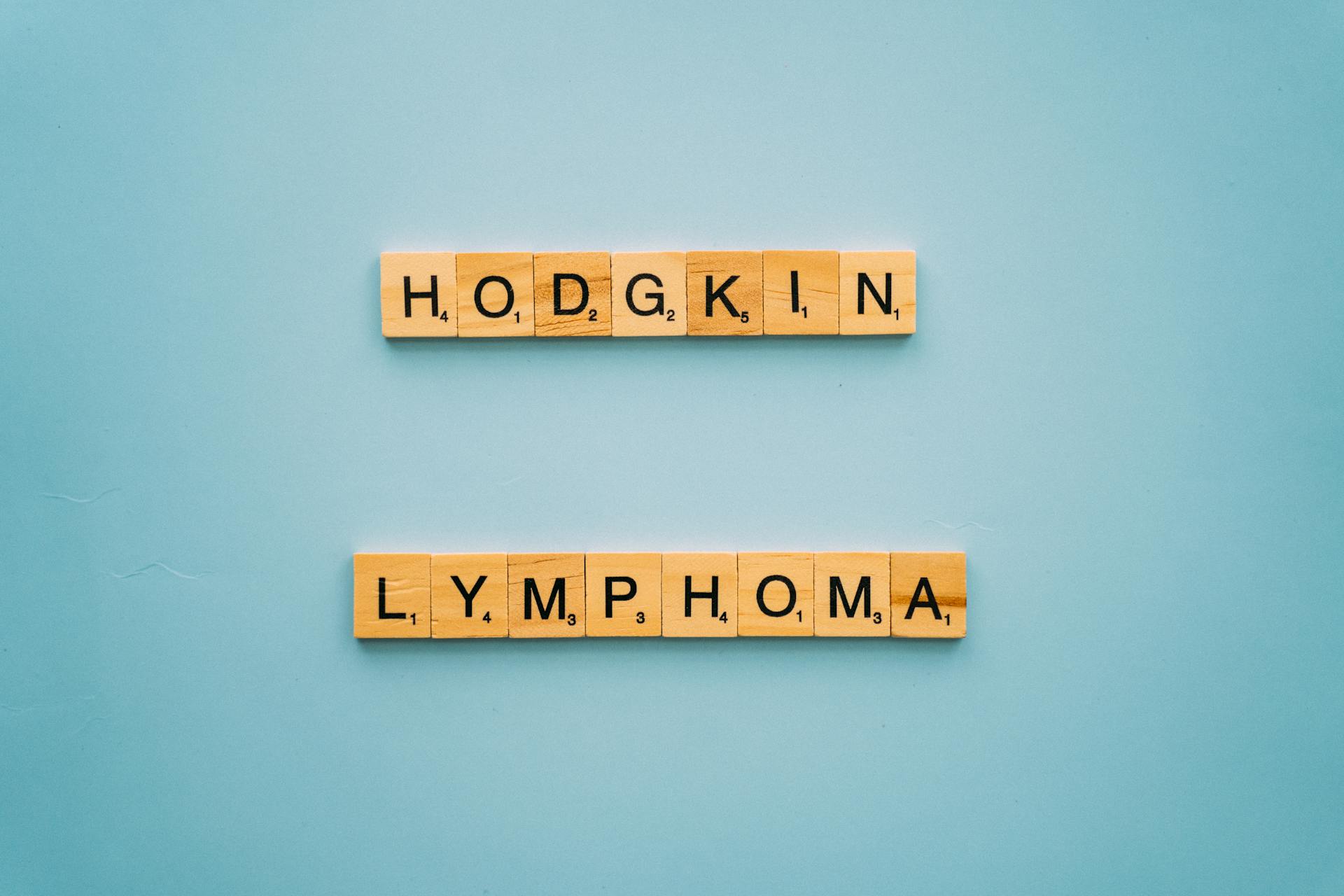
Canine cancer is a devastating disease that affects many dogs worldwide. Genetics play a significant role in the development of cancer in dogs, with some breeds being more prone to certain types of cancer.
Studies have shown that inherited genetic mutations can increase a dog's risk of developing cancer. For example, the BRCA2 gene mutation has been linked to an increased risk of breast cancer in dogs.
Environmental factors also contribute to the development of canine cancer. Exposure to certain chemicals, such as pesticides and heavy metals, has been shown to increase a dog's risk of developing cancer.
Diet and lifestyle can also impact a dog's risk of developing cancer. A diet high in processed foods and low in nutrients may contribute to an increased risk of cancer.
A fresh viewpoint: Bland Diet for Dogs with Pancreatitis
What Is Cancer?
Cancer is a complex and multifaceted disease.
A neoplasm is the abnormal and uncontrolled growth of any new cells or tissues in the body. It's the starting point for cancer, but not all neoplasms lead to cancer.
A tumor is a detectable raised cell mass that can be benign or malignant. Some tumors are harmless, while others are cancerous.
Metastasis occurs when a tumor or neoplasm spreads to other tissues in the body, and it's graded based on its progress, usually from Stage I to Stage V. The higher the stage, the more deadly cancer becomes.
Carcinomas are malignant tumors that signal cancer in certain organs, glands, and skin. This is a specific type of cancer that affects these areas.
Sarcomas are malignant tumors that signal cancer in supportive tissue, such as bones, fats, muscles, fascia, or blood. This is another type of cancer that affects different parts of the body.
Remission is a process where the symptoms and spread of cancer can be treated, and a cancer patient can enter partial or full remission.
Causes and Susceptibility
Cancer in dogs is a complex and multifaceted issue, and understanding its causes can help us better prevent and manage it.
Cancer is a disease that arises from DNA mutations, chromosomal translocations, and dysfunctional proteins. These mutations can be inherited, caused by environmental factors, or occur spontaneously.
Certain breeds are more susceptible to specific types of cancer due to selective breeding techniques. For example, Boxers, Boston Terriers, and Golden Retrievers are prone to mast cell tumors.
Age is a significant risk factor for cancer in dogs, with cancer prevalence increasing with age. Millions of dogs develop spontaneous tumors each year.
Dogs eating higher amounts of red meat, especially beef and pork, are more likely to get mammary cancer. A study of 144 female dogs found this correlation.
Spaying female dogs can decrease the risk of cancers affecting the mammary glands, ovaries, and other reproductive organs. Neutering males can also reduce the risk of prostate cancer.
However, neutering can increase the risk of osteosarcoma and hemangiosarcoma in either sex.
Here are some of the general causes of cancer in dogs:
- Age
- Viruses and infections
- Chemical and toxin exposure
- Genetics
- DNA mutations
- UV damage or other environmental triggers
Signs and Symptoms
Weight loss and lack of appetite are common signs of cancer in dogs, but they can also be caused by other factors, so it's essential to monitor your dog's overall health.
Some lumps and bumps on dogs can be benign, but without testing, it's impossible to know for sure if they're cancerous.
Dogs with cancer can exhibit a range of symptoms, including new lumps or bumps, swollen lymph nodes, abnormal bleeding, and wounds that don't heal.
Here are some nonspecific symptoms that may indicate cancer in dogs:
- Abdominal distension
- Behavioral changes or neurological issues like seizures or head tilt
- Coughing or changes in respiration
- Decreased appetite and weight loss
- Exercise intolerance
- Pale gums
- Lethargy
- Vomiting and/or diarrhea
Lumps on dogs can be firm and immovable, or soft and pliable, and may or may not be painful to the touch.
Lymph nodes can become enlarged and may be a symptom of cancer, so it's essential to differentiate them from other lumps and bumps.
If you notice any of these symptoms or find a new lump on your dog, schedule an appointment with your veterinarian for an accurate diagnosis.
Diagnosis and Treatment
Early detection is key to treating canine cancer effectively. Most cancers are more amenable to being removed when they're smaller.
A veterinarian will typically start by performing a physical exam to look for any abnormal or unexplained lumps, bruises, or masses. This is usually followed by a fine-needle aspirate (FNA) of the mass, where a sample of the tumor is collected and submitted for analysis.
Bloodwork and urine testing help narrow down the problem to a specific organ or body system. Imaging with radiographs or ultrasound may also be recommended to screen for masses in the chest or abdomen.
The prognosis will vary depending on the type of cancer, its grade, and stage. The higher the grade and greater the stage, the worse the prognosis.
There are three main options for cancer treatment in dogs: surgery, radiation, and chemotherapy. Some cancers may respond to one type of treatment, while others may require a combination of some or all.
Here are some common chemotherapy medications used to treat canine cancer:
- Carboplatin
- Chlorambucil
- Cyclophosphamide
- Doxorubicin
- L-asparaginase
- Lomustine
- Mitoxantrone
- Palladia
- Prednisone
- Vinblastine
- Vincristine
In some cases, a combination of treatments may be necessary to achieve a favorable prognosis.
Specific Types of Cancer
Canine cancer is a complex and multifaceted topic, but one thing is clear: there are many types of cancer that can affect our furry friends. Some of the most common types of cancer in dogs include hemangiosarcoma, which can occur in the spleen, liver, and skin, and is often seen in breeds like German Shepherds, Golden Retrievers, and Labrador Retrievers.
Hemangiosarcoma is a fast and deadly cancer that can be difficult to treat, so it's essential to catch it early. Another type of cancer that affects dogs is melanoma, which can occur on the skin or in the mouth, and is more common in breeds like Chow Chows, Miniature Schnauzers, and Scottish Terriers.
Here are some specific types of cancer that can affect dogs:
These are just a few examples of the many types of cancer that can affect dogs. If you're concerned about your pet's health, it's always best to consult with a veterinarian who can provide personalized advice and care.
Types of Cancer

Hemangiosarcoma is a common type of cancer in dogs, often found in the spleen, liver, heart, or skin. It's a fast and deadly cancer, usually untreatable by the time it's detected.
Hemangiosarcoma is most commonly seen in German Shepherd dogs, Golden Retrievers, and Labrador Retrievers, but any dog can develop this cancer.
Mast cell tumors are the most common canine skin tumor, usually arising on or just below the skin in dogs. They can occasionally arise inside the chest or abdominal cavities.
Mast cell tumors are usually not painful, but persistent swellings on or under the skin can be a warning sign. Diagnosis is usually achieved by taking a sample from the swelling using a fine needle aspirate.
Mast cell tumors can be treated with surgery to remove the tumor, and in some cases, radiation therapy and/or chemotherapy may be recommended.
Lymphoma is the most common cancer in dogs and cats, making up 20% of all canine cancer cases and 30% of all tumors in cats. It starts in the lymphatic system and can fall under several categories, including multicentric, alimentary, mediastinal, and extranodal.
On a similar theme: Is It Okay to Put Ice in Dogs Water

Certain breeds, such as Bernese Mountain Dogs, boxers, bulldogs, bullmastiffs, and Scottish Terriers, may have a higher likelihood of developing lymphoma.
The most common types of cancer in dogs include:
- Hemangiosarcoma
- Mast cell tumors
- Lymphoma
- Anal Sac Adenocarcinoma
- Hemangiosarcoma
- Mammary Gland Carcinoma
- Mast Cell Tumor
- Melanoma
- Osteosarcoma
- Transitional Cell Carcinoma
These types of cancer can affect different parts of the body, such as the skin, spleen, liver, heart, lymph nodes, rectum, and bladder.
Nasal Tumors
Nasal Tumors can be a serious issue for dogs, and it's essential to know the warning signs. Blood dripping from one side of the nose, sneezing, facial disfigurement, or protrusion of an eyeball are all potential warning signs.
A CT scan is usually recommended to determine why a dog is experiencing these symptoms. This diagnostic test can help identify a mass lesion in the nasal cavity.
The most commonly recommended treatment option for dogs with nasal tumors is radiation therapy. This is because surgery alone is not effective in removing all the tumor cells from the nasal cavity.
Treatment for nasal tumors can temporarily resolve clinical signs, improve a dog's quality of life, and prolong survival.
See what others are reading: Canine Cancer Treatment
Frequently Asked Questions
Is there a way to prevent cancer in dogs?
To reduce the risk of cancer in dogs, provide a healthy diet, regular exercise, and a safe living environment by avoiding toxic substances and excessive sun exposure. Understanding your dog's breed history can also help identify potential cancer risks.
What is the most aggressive cancer in dogs?
Hemangiosarcoma is a highly aggressive cancer in dogs that requires immediate attention. It's a rapidly growing tumor that can spread to various organs, including the spleen, heart, and lungs.
Sources
- https://www.ahofstatesville.com/services/dogs/dog-cancer
- https://www.papayapet.com/resources/12-types-of-cancers-in-dogs-and-cats/
- https://uwveterinarycare.wisc.edu/common-types-of-cancer-in-dogs/
- https://en.wikipedia.org/wiki/Cancer_in_dogs
- https://www.petmd.com/dog/conditions/cancer/cancer-dogs-symptoms-types-and-treatment
Featured Images: pexels.com


